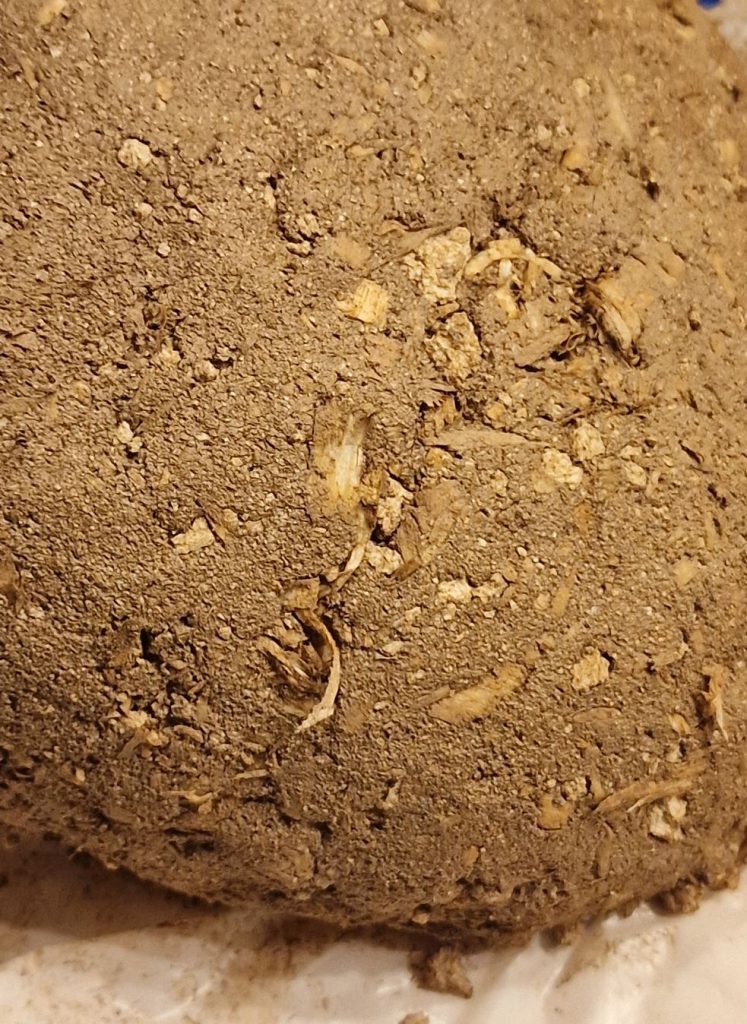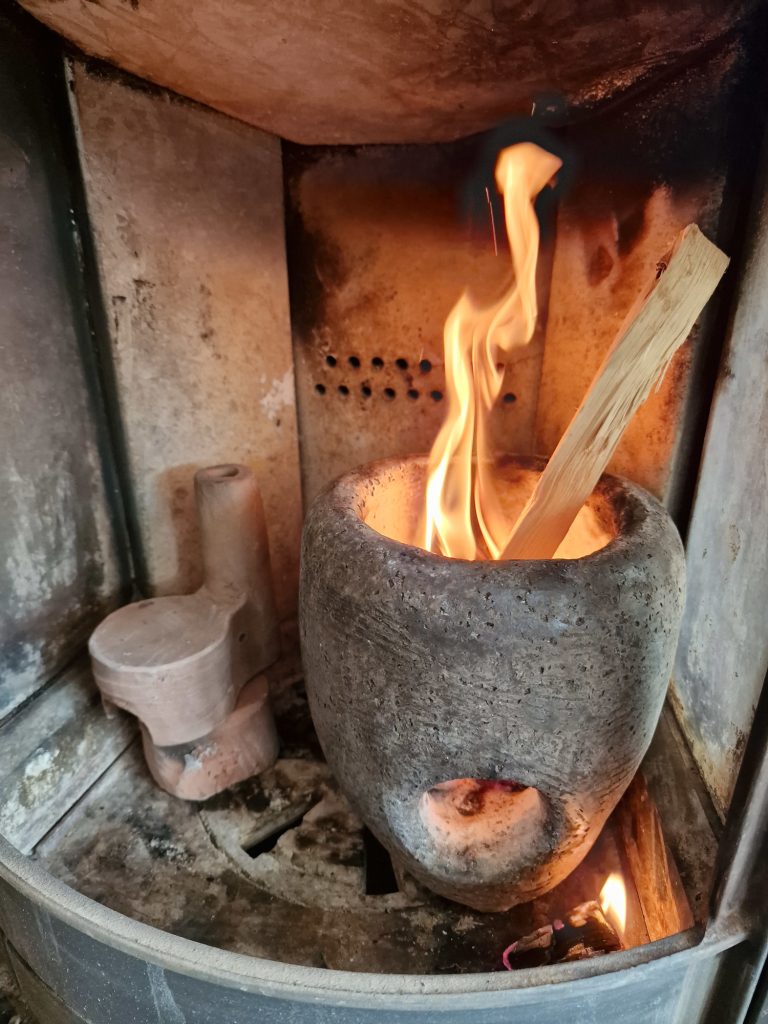
Cooking wares, oven wares, garden kilns, pizza stones, and isolation in your wood stove. You find refractories everywhere in your daily life.
(If you want to skip the blah blah blah and jump to the receipts, scroll down in the article)
How To Make Homemade Fireclay
So what is Fireclay?
Refractory clay – Mortar clay – Fire clay – Flame safe – Flameware – Ovenware
Certainly, there are many categories, but for potters, I guess this is the goal:
Fireclay for ceramic artist is about making a clay with high modeling quality and low shrinkage: That needs to withstand direct flames, uneven heating, and rapid temperature changes. Flameware / Fireclay are simply ceramics with low-temperature expansion, that withstand high-temperature changes without cracking.
How to make fireclay with modeling qualities seems to be a well-kept industrial secret, I know it sounds a bit paranoid since refractories are used everywhere. But a recipe for a good, flame-safe ceramic clay with high modeling qualities is nowhere to be seen.
Well, you can stumble upon a receipt from time to time: But when you try them, they are just not as flame-safe as they claim to be, the receipt is incomplete, not refractory at all, or made by unrealistic expensive components.
I’m not a refractory expert, I’m a ceramist, and here I share with you what I have learned so far in my search for a better receipt. If you disagree with my conclusions or have a receipt that outperforms mine. I would like to hear from you. (email me at: hello@woodfireceramic.com)

How To Make Homemade Fireclay
All flame-safe clay have something in common, they are all made of:
- Grog, to reduce shrinking
- Woodchips or small objects burn away, to reduce weight
- Refractory materials
- Component to increase plasticity
Fireclay is made of clay and aluminium oxides
www.brunner.com
Worn out Saggars and material stress:
I have burned my best Fireclay receipts 20 + times with no big cracks, but small cracks on the inside tell me that direct flames are tough and that my firepot is not going to live forever. That’s something I also have read about Saggars (a Saggar is a box used inside the kiln to protect wares from direct flames), fireclay saggars were said to be used 30-40 times before they were worn out.

Refractory materials:
Five oxides with special importance in refractory materials:
Al₂O₃ Aluminium oxide
MgO Magnesium oxide
BeO Beryllium oxide
ZrO₂ Zirconium dioxideThO₂
ThO₂ Hydrogen peroxide
Firebricks are made of high-temperature clay, sold in four grades:
- Superduty
- High Heat Duty
- Medium Heat Duty
- Low Heat Duty
“Fireclays are often just the crude form of ball clays”
Kilns. Design, Combustion, and Operation – Daniel Rhodes
Soft bricks are made of diatomaceous earth, or Fuller’s earth. Diatomaceous earth is a natural deposit of diatom. This material is porous, soft, and light. It largely contains Silicon Dioxide.
How To Make Homemade Fireclay:
“Tapron 11” Fireclay – My best homemade Fireclay:

I fired it to strong heat inside the ring, while the outside did not receive enough heat to transform to ceramic. No cracks yet and I see that as a good sign.



Picture 1 – Grounded soft refractory bricks
Picture 2 – Fine wood chips
Picture 3 – The fireclay mix, is quite plastic but only for rough modeling with few details.
I call this “sore fingers clay”, don’t throw it unless you have skin thick as an elephant.
Receipt:
- 2 part Craft Crank 2,4 kg (wet from the bag, this clay got 40% fine chamotte)
- 1 part / 400g Grounded soft refractory bricks
- 1 part / 340g Talc
- 2 part / 110g Fine wood chips (I prefer wood chips over Perlite since it makes longer voids)
- 1/6 part 80g Bentonite (makes it both plastic & sticky, adjust it, mix dry with the rest)
- 1 part / 560g Water (the mix ended up a bit too wet).
Craft-Crank is a fantastic strong clay, it can handle almost anything, the best construction clay around. Big sculptures keep their shape without cracking or misshaping even when burned at 1300 degrees.
But it doesn’t handle a bar flame, let’s hope this receipt improves it.
“Tapron 7” Fireclay – My most tested homemade Fireclay, first version:

This has been my best so far, it does the job but is quite heavy
Works quite well, is plastic, and withstands direct flames and quick temperature changes, but after 20 firings it starts to show some fine cracks on the surface.
Receipt in volume, not in weight:
- 2 part Crank (wet from the bag) this clay has 40% fine chamotte
- 1 part Ballclay (makes it quite sticky, try to reduce the amount?)
- 1 part Grog
- 2 part Perlite
- 1 part fine wood chips
“Pippa” White Fireclay (untested):
Recipe in volume:
- 2 part Kaoline
- 2 part Talc
- ½ part Ballclay, just enough to make it stick together
- 2 part Molochite
- 2 part wood chips
Grog is high-burned and crushed ceramic, it helps against shrinking, but does the Grog itself have low-temperature expansion? If not, it’s not a refractory solution. I try Molochite instead. Kaolin is very refractory but shrinks a lot the first time fired, test it, but if it cracks, replace Kaolin with Crank.
“Darbin” Fireclay – Porous Fireclay with Talc:

In volume:
1 part talc
1 part ball clay
2 part grog
2 part perlite
Promising!
Coarse, porous, low modeling ability, too sticky when wet, to crumble when dry, low green-strength. So I don’t like the wet quality, but: It soaks water quickly and it spreads to the whole clay mass in no time (that’s good). It can with difficulties be modeled in simple shapes, can be “hammered” to plates, and possibly also pressed into forms. It’s quite hard after it’s burned, and seems to handle uneven heating and rapid temperature changes really well.
This is an interesting mix (but I have not tested it over 700 degrees).

“Charlot” Fireclay – Porous Clay Body (Untested):
1 part talc (refractory)
1 part Molochite (refractory fine particle grog)
1 part Dolomite (refractory, makes the Fireclay porous)
1 part Ball Clay (for plasticity)
1 part Perlite (weight reduction)
According to this source: https://digitalfire.com/glossary/clay+body+porosity
A Receipt with:
65% Dolomite
35% Ball Clay
5% Ferro frit 3110 (so the fired body does not rehydrate).
Gives a clay body porosity of 35%.
I believe porosity is beneficial for Fireclay to spread the heat evenly, and for Fast Fire Clay to quickly get rid of moisture so it does not crack.
Industrial-produced firebricks are made under heavy pressure and almost no water. Homemade fireclay can not be molded under such conditions, but with a flat hammer, it’s possible to “hammer” the clay into the molds, to make it more compact and reduce voids.
Some refractory receipts:
I have not tested these:
“A high-quality material can be made using a three-part mix of kaolin, silica, and ball clay, it can support 25% grog without problem and fires white and very refractory”. This source says: https://digitalfire.com/glossary/fireclay
Raku clay
Raku clay needs to be refractory, though it only needs shock resistance one time:
Raku clay often has an open claybody structure and can contain: Kyanite, spodumene, talc, flint, feldspar, and fireclay.
Refractory clay:
30 parts stoneware clay
1 part Alumina Hydrate
1 part Zircon
Add perlite and grog
Saggar formulas:
Var 1:
50% grog
40% China clay
10% Bounding clay( ball clay?)
Var 2:
40% grog
20% China clay
20% Ball clay
20% Talc
Var 3:
2 part Fireclay
1 part Ball clay
1 part Grounded soft bricks
2 part Coarse sawdust
Homemade refractory bricks:
Var 1:
70 parts vermiculite
15 parts ball clay
Add some Sodium silicate to make it stronger
Var 2:
3 part sawdust
1 part fireclay
1 part ball clay
Add some Sodium silicate to make it stronger
Since Fireclay for ceramic artists is a lot about plasticity, and ceramic materials like Ball clay and Bentonite also make the Fireclay sticky. To receive plasticity with organic materials looks promising (though it will start to rot and smell bad after just some days, so work fast):
See the “The alchemist clay”:
https://www.youtube.com/embed/HbLdNKM9y68
And his updated process: “Making Alchemist’s Clay: My Updated Process”
https://www.youtube.com/embed/vBAzZHIFb0o
Also, see the material list:
And read about the ceramics fluxes:
Failed – Sculptural fireclay:
It cracked after 5 minutes in the first try, back to testing
Receipt in volume, not in weight:
- 5 parts commercial Fireclay (Fireclay 4016 BSZ: Content analysis here)
- 1 part Talc
- ½ part Bentonite
- 1 part Ballclay
- Add a lot of chamotte
More links about refractories:
https://www.hunker.com/12003493/what-is-the-difference-between-lime-cement
https://cone6pots.ning.com/forum/topics/6-flameware-clay-body-recipe
https://digitalfire.com/glossary/flameware
https://digitalfire.com/material/fireclay
https://ceramicartsnetwork.org/ceramic-recipes/recipe/Flameware-Clay-Body-143686#
https://www.traditionaloven.com/articles/101/what-is-fire-clay-and-where-to-get-it
https://www.instructables.com/Clay-Crucible-Recipes/
https://studiopotter.org/flameware-journey